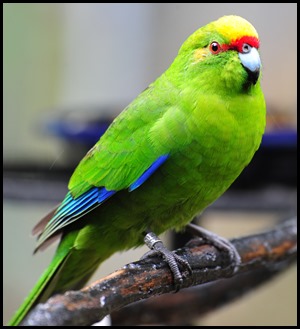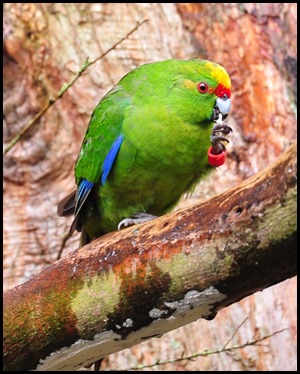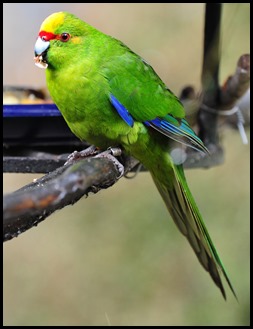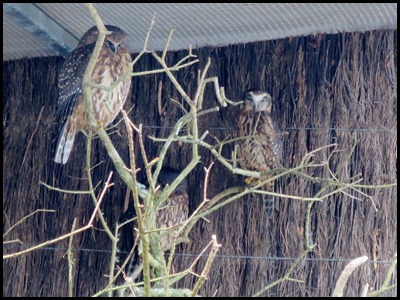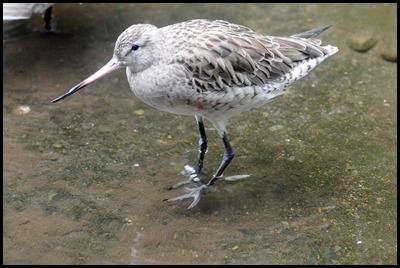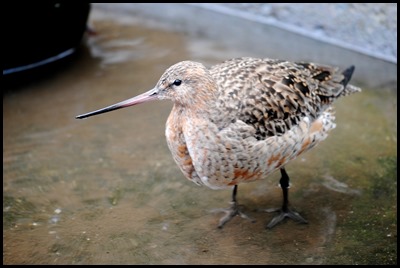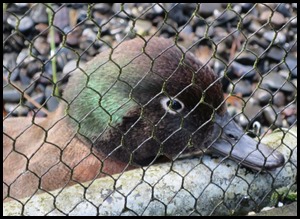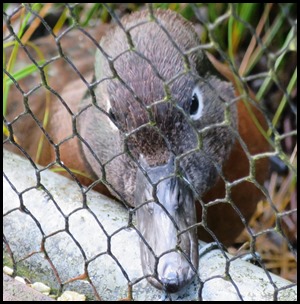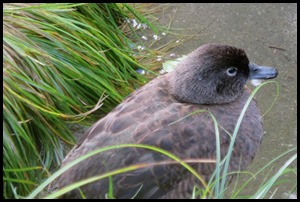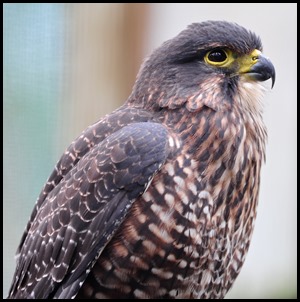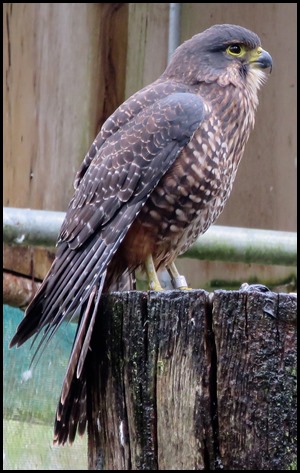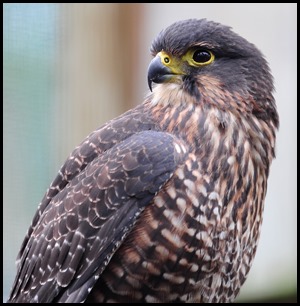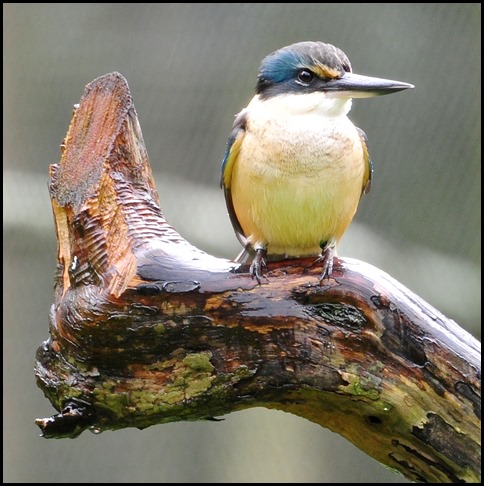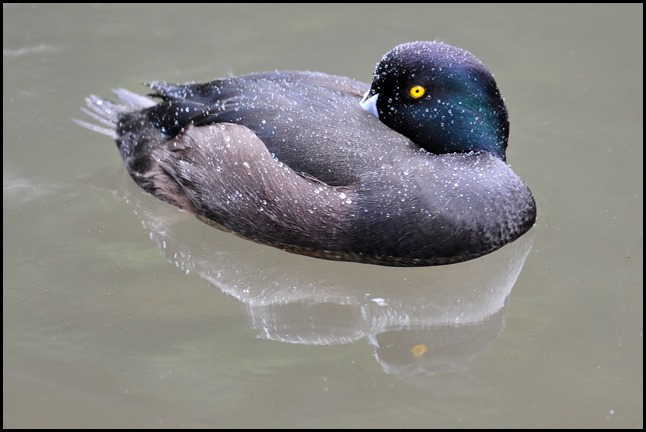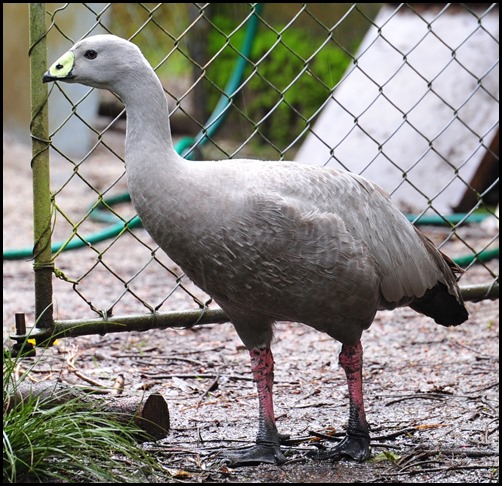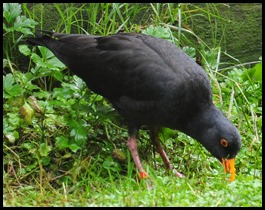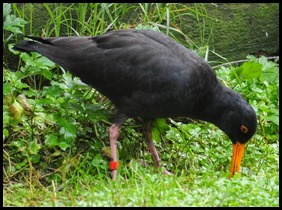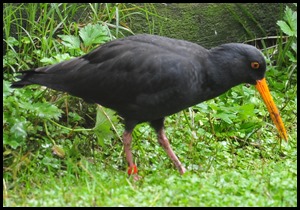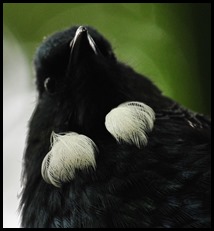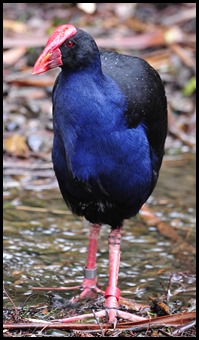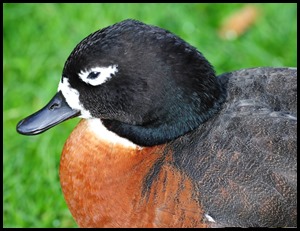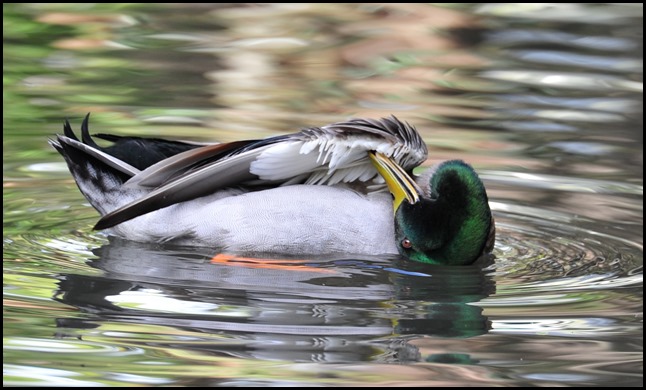Kiwi House Part 2

|
Kiwi House – Part
Two
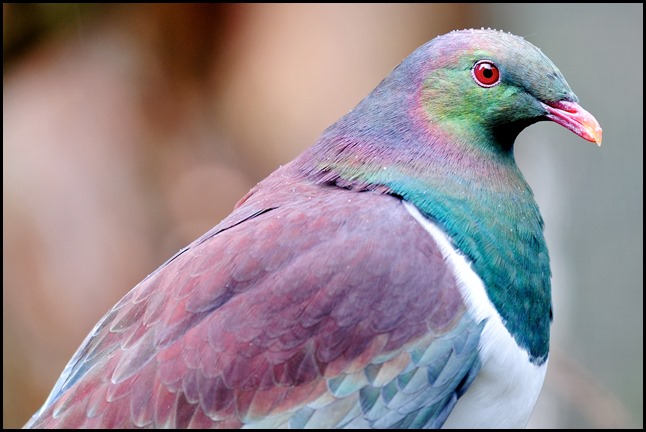 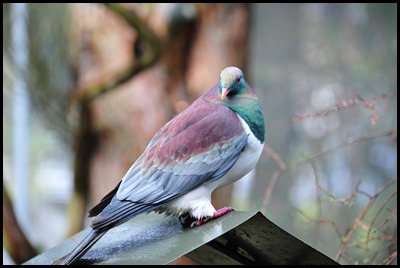 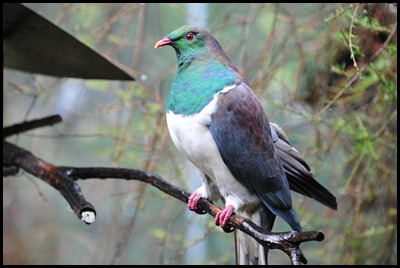 This is Woody, a big chap standing twenty inches. These birds weigh anything between nineteen to thirty ounces, rather handsome though. This particular chap like to sit on a suspended branch and be swung by his keeper.
In the same flight as Woody were these rather pretty karariki or red crowned parakeets. A colourful parrot, they are found in forests and scrublands of North and South Island, now listed as vulnerable on the international list of threatened birds. Karariki were hunted in the 1880’s by European settlers protecting their crops and the birds forest habitat was much reduced by logging. Because the bird nests in ground burrows and holes in trees they became easy targets of the newly introduced pest brought by the settlers – possums and rats especially. The chicks were and are at greatest risk as they feed on the ground until they learn to fly. Closely related, similar looking parrots are found on the Kermadec Islands, Chatham and Norfolk Island, Antipodes Islands and New Caledonia.
Morepork, we have often heard but never seen ruru as the Māori call them, we thought they looked suitably snooty. They have quite a name in Latin – ninox novaeseelandiae. Found in lowland forests, pine plantations and parkland, morepork rest during the day, leaving their roost at dusk to hunt. Breeding pairs will maintain a territory of several hectares. Their European and Māori names reflect their distinctive, repetitive call. They also make a screeching sound while hunting and a shrill cree cree sound during the mating season. Not fussy – they will make their simple nests in tree hollows, clusters of epiphytes, caves, riverbank burrows and even on the ground amongst boulders – sound like Bear getting his napper down wherever........ Morepork lay two eggs in October or November. The female does all the incubation but is kept fed by her partner.
The eastern bar-tailed godwit known locally as kuake, are an indigenous species to New Zealand. Up to a 100,000 of these birds migrate from their breeding grounds in Siberia and Alaska, arriving in New Zealand in mid September, before departing in late March. An 11,0000 kilometre non-stop journey over the Pacific, when they arrive they are bedraggled from fasting. Birds can be observed on all three main islands, feeding in loose groups on the intertidal mud flats in search for crustaceans, molluscs and worms. Recognised by their long legs, long slightly up curved mandible. Plumage is mottled dull brown and white. Broad, whitish eyebrow stripe. Flesh coloured mandible, dark greenish-grey legs. By February they have fattened up and ready to show off their breeding colours. During the breeding season, the males plumage changes to a reddish chestnut, from its neck down to the breast and belly. Many flocks come together before the migration and make frequent restless spiralling flights. While most make the return journey – via Australia or New Guinea, and northern Asia, rather than direct, about ten per cent mainly non-breeding juveniles, remain in New Zealand over winter. These birds were injured and handed in by Bird Rescue of Auckland. Their wing injuries make their migration impossible.
This is one of the world’s rarest ducks and their natural home is an island in the remote sub-Antarctic. In the 1990’s rats brought the species to the brink of extinction but a few had found refuge on, tiny, rat-free, Dent Island. A captive breeding programme proved successful and in 2004, when rats were eradicated from Campbell Island, the offspring of those first lucky survivors made the long journey home. Some are still held in captivity as a back-up to the island population. Flightless and nocturnal, Campbell Island teal have long claws and short stiff tail feathers which are useful on the rocky islands. In breeding season males develop rich chestnut-coloured feathers round their chest and a green sheen on their head. Zappa is very territorial and spends his day marching up and down protecting his shy girlfriend.
The New Zealand Falcon is bred here and as soon as the chicks have fledged they are sent to Wingspan. Wingspan Birds of Prey Trust is based in Rotorua and is at the forefront of falcon conservation. They were registered in 1992 and care for sick, injured and orphaned raptors and, if possible, release them back into the wild. Wingspan also breeds falcons or uses the birds as foster parents. They practice the ancient art of falconry as a tool for rehabilitation. There are only six people in New Zealand that hold permits to keep birds and practice the art, five of them work for Wingspan. Free flight training involves using a leather lure, allowing the birds to fly free, swooping on the meat tucked into the lure that the trainer has tossed into the air, this encourages the bird to strike mid-air. Sometimes the trainer snatches the lure away from the bird simulating prey escaping, this teaches the bird to turn quickly and attack again. Wingspan releases as many birds as possible once they are rehabilitated or trained. Unfortunately some are too badly injured, these are kept as foster parents, others become too tame and risk being hunted or hit by road traffic. There is a release area of choice ten minutes north of here on Mount Kakapuku.
A very handsome Australian kingfisher.
We saw loads of these little beauties, very amusing, they were trying to sleep, one eye on what was going on, one foot slowly flapping them in circles. The black teal is a true diver, up to thirty seconds to a depth of ten feet. The day the babies hatch they can can dive - but not as far or for as long until they are a little big bigger.
The pig goose, a new one on us. There are a few captive populations of this large bird in New Zealand. They were hunted almost to extinction in their native Australia by the 1900’s. Now protected, around 20,000 birds live on the islands along Australia’s south coast. However, they are still one of the rarest geese in the world. Its family history is confusing. It looks and acts like a goose but has the breeding behaviours of a swan. It has genetic similarities to swans and shelducks, but its bone structure is most similar to New Zealand’s own long-extinct goose. They mate for life but spend the summer grazing in large flocks. Females lay four to five white eggs which both birds will defend aggressively. Males make a trumpet-like honk while females have a deeper grunting call.
On first looking at what we thought was a blackbird, as his head bobbed up, none other than a black oystercatcher. The rain kept falling but Thora stuck with us until we bade her farewell. The best of the rest.
ALL IN ALL A FUN VISIT DESPITE THE WEATHER FANTASTIC TO SEE OUR FIRST KIWI, GOOD WEATHER FOR US DUCKS |
